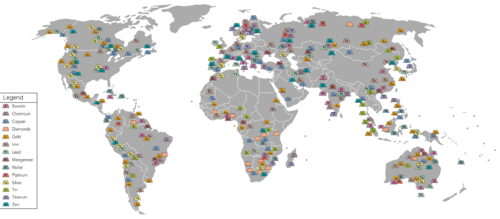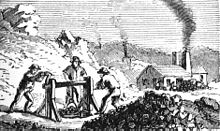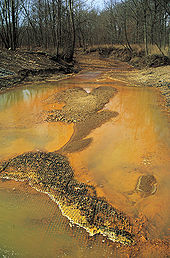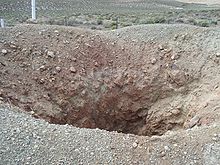- Mining
-
This article is about the extraction of geological materials from the Earth. For the municipality in Austria, see Mining, Austria. For the siege tactic, see Mining (military). For name of the Chinese emperor, see Daoguang Emperor.
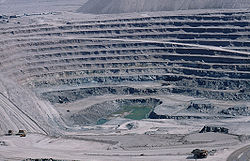 Chuquicamata, Chile, site of the largest circumference and second deepest open pit copper mine in the world.
Chuquicamata, Chile, site of the largest circumference and second deepest open pit copper mine in the world.
Mining is the extraction of valuable minerals or other geological materials from the earth, from an ore body, vein or (coal) seam. The term also includes the removal of soil. Materials recovered by mining include base metals, precious metals, iron, uranium, coal, diamonds, limestone, oil shale, rock salt and potash. Any material that cannot be grown through agricultural processes, or created artificially in a laboratory or factory, is usually mined. Mining in a wider sense comprises extraction of any non-renewable resource (e.g., petroleum, natural gas, or even water).
Mining of stone and metal has been done since pre-historic times. Modern mining processes involve prospecting for ore bodies, analysis of the profit potential of a proposed mine, extraction of the desired materials and finally reclamation of the land to prepare it for other uses once the mine is closed.
The nature of mining processes creates a potential negative impact on the environment both during the mining operations and for years after the mine is closed. This impact has led to most of the world's nations adopting regulations to moderate the negative effects of mining operations. Safety has long been a concern as well, though modern practices have improved safety in mines significantly.
Contents
History of Miners
Prehistoric mining
Chalcolithic copper mine in Timna Valley, Negev Desert, Israel.
Since the beginning of civilization, people have used stone, ceramics and, later, metals found on or close to the Earth's surface. These were used to manufacture early tools and weapons, for example, high quality flint found in northern France and southern England were used to create flint tools.[1] Flint mines have been found in chalk areas where seams of the stone were followed underground by shafts and galleries. The mines at Grimes Graves are especially famous, and like most other flint mines, are Neolithic in origin (ca 4000 BC-ca 3000 BC). Other hard rocks mined or collected for axes included the greenstone of the Langdale axe industry based in the English Lake District.
The oldest known mine on archaeological record is the "Lion Cave" in Swaziland, which radiocarbon dating show to be about 43,000 years old,.[citation needed] At this site paleolithic humans mined mineral hematite, which is Iron oxide (similar to rust), was ground to produce the red pigment ochre.[2][3] Mines of a similar age in Hungary are believed to be sites where Neanderthals may have mined flint for weapons and tools.[citation needed]
Ancient Egypt
Ancient Egyptians mined malachite at Maadi.[4] At first, Egyptians used the bright green malachite stones for ornamentations and pottery. Later, between 2613 and 2494 BC, large building projects required expeditions abroad to the area of Wadi Maghara in order "to secure minerals and other resources not available in Egypt itself."[5] Quarries for turquoise and copper were also found at "Wadi Hamamat, Tura, Aswan and various other Nubian sites"[5] on the Sinai Peninsula and at Timna.
Mining in Egypt occurred in the earliest dynasties, and the gold mines of Nubia were among the largest and most extensive of any in Ancient Egypt, and are described by the Greek author Diodorus Siculus. He mentions that fire-setting was one method used to break down the hard rock holding the gold. One of the complexes is shown in one of earliest known maps. They crushed the ore and ground it to a fine powder before washing the powder for the gold dust.
Ancient Greece and Rome
See also: Mining in Roman Britain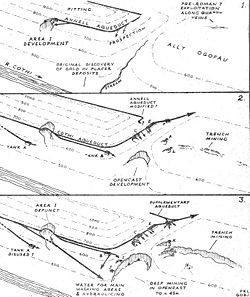 Ancient Roman development of the Dolaucothi Gold Mines, Wales.
Ancient Roman development of the Dolaucothi Gold Mines, Wales.
Mining in Europe has a very long history, examples including the silver mines of Laurium, which helped support the Greek city state of Athens. However, it is the Romans who developed large scale mining methods, especially the use of large volumes of water brought to the minehead by numerous aqueducts. The water was used for a variety of purposes, including using it to remove overburden and rock debris, called hydraulic mining, as well as washing comminuted or crushed ores, and driving simple machinery.
The Romans used hydraulic mining methods on a large scale to prospect for the veins of ore, especially a now obsolete form of mining known as hushing. It involved building numerous aqueducts to supply water to the minehead where it was stored in large reservoirs and tanks. When a full tank was opened, the wave of water sluiced away the overburden to expose the bedrock underneath and any gold veins. The rock was then attacked by fire-setting to heat the rock, which would be quenched with a stream of water. The thermal shock cracked the rock, enabling it to be removed, aided by further streams of water from the overhead tanks. They used similar methods to work cassiterite deposits in Cornwall and lead ore in the Pennines.
The methods had been developed by the Romans in Spain in 25 AD to exploit large alluvial gold deposits, the largest site being at Las Medulas, where seven long aqueducts were built to tap local rivers and to sluice the deposits. Spain was one of the most important mining regions, but all regions of the Roman Empire were exploited. They used reverse overshot water-wheels for dewatering their deep mines such as those at Rio Tinto. In Great Britain the natives had mined minerals for millennia ,[6] but when the Romans came, the scale of the operations changed dramatically.
The Romans needed what Britain possessed, especially gold, silver, tin and lead. Roman techniques were not limited to surface mining. They followed the ore veins underground once opencast mining was no longer feasible. At Dolaucothi they stoped out the veins, and drove adits through barren rock to drain the stopes. The same adits were also used to ventilate the workings, especially important when fire-setting was used. At other parts of the site, they penetrated the water table and dewatered the mines using several kinds of machine, especially reverse overshot water-wheels. These were used extensively in the copper mines at Rio Tinto in Spain, where one sequence comprised 16 such wheels arranged in pairs, and lifting water about 80 feet (24 m). They were worked as treadmills with miners standing on the top slats. Many examples of such devices have been found in old Roman mines and some examples are now preserved in the British Museum and the National Museum of Wales.[7]
Medieval Europe
 Agricola, author of De Re Metallica
Agricola, author of De Re Metallica
See also: Mining in the Harz Mountains.
Mining as an industry underwent dramatic changes in medieval Europe. The mining industry in the early Middle Ages was mainly focused on the extraction of copper and iron. Other precious metals were also used mainly for gilding or coinage. Initially, many metals were obtained through open-pit mining, and ore was primarily extracted from shallow depths, rather than though the digging of deep mine shafts. Around the 14th century, the demand for weapons, armor, stirrups, and horseshoes greatly increased the demand for iron. Medieval knights for example were often laden with up to 100 pounds of plate or chain link armor in addition to swords, lances and other weapons.[8] The overwhelming dependency on iron for military purposes helped to spur increased iron production and extraction processes.
These new military applications coincided with a population explosion throughout Europe in the 11th-14th centuries which enriched the demand for precious metals in order to fill a currency shortage.[9] The silver crisis of 1465 occurred when the mines had all reached depths at which the shafts could no longer be pumped dry with the available technology.[10] Although the increased use of bank notes and the use of credit during this period did decrease the dependence and value of precious metals, these forms of currency still remained vital to the story of medieval mining. Use of water power in the form of water mills was extensive; they were employed in crushing ore, raising ore from shafts and ventilating galleries by powering giant bellows. Black powder was first used in mining in Selmecbánya, Kingdom of Hungary (present-day Banská Štiavnica, Slovakia) in 1627.[11] Black powder allowed blasting of rock and earth to loosen and reveal ore veins, which was much faster than fire-setting, in which rock was exposed to heat and then doused with cold water. Black powder allowed the mining of previously impenetrable metals and ores.[12] In 1762, the world's first mining academy was established in the same town.
The widespread adoption of agricultural innovations such as the iron plowshare, as well as the growing use of metal as a building material, was also a driving force in the tremendous growth of the iron industry during this period. Inventions like the arrastra were often used by the Spanish to pulverize ore after being mined. This device employed animal power and utilized mechanical principles similar to that of the ancient Middle Eastern technology of grain threshing.[13]
Much of our knowledge of Medieval mining techniques comes from books such as Biringuccio’s De la pirotechnia and probably most importantly from Georg Agricola's De re metallica (1556). These books detail many different mining methods used in German and Saxon mines. One of the prime issues confronting medieval miners (and one which Agricola explains in detail) was the removal of water from mining shafts. As miners dug deeper to access new veins, flooding became a very real obstacle. As a result the mining industry became dramatically more efficient and prosperous as the use of various mechanical and animal driven pump systems were implemented.
North and South America
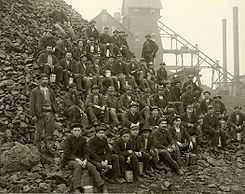 Miners at the Tamarack Mine in Copper Country, Michigan, U.S. in 1905.
Miners at the Tamarack Mine in Copper Country, Michigan, U.S. in 1905.
There are ancient, prehistoric copper mines along Lake Superior, and metallic copper was still found there, near the surface, in colonial times. [14] [15] [16] Indians availed themselves of this copper starting at least 5000 years ago,"[14] and copper tools, arrowheads, and other artifacts that were part of an extensive native trade network have been discovered. In addition, obsidian, flint, and other minerals were mined, worked, and traded.[15] While the early French explorers that encountered the sites made no use of the metals due to the difficulties in transporting it,[15] the copper was eventually traded throughout the continent along major river routes. In Manitoba, Canada, there also are ancient quartz mines near Waddy Lake and surrounding regions.[17]
In the early colonial history of the Americas, "native gold and silver was quickly expropriated and sent back to Spain in fleets of gold- and silver-laden galleons"[18] mostly from mines in Central and South America. Turquoise dated at 700 A.D. was mined in pre-Columbian America; in the Cerillos Mining District in New Mexico, estimates are that "about 15,000 tons of rock had been removed from Mt Chalchihuitl using stone tools before 1700."[19][20]
Mining in the United States became prevalent in the 19th century, and the General Mining Act of 1872 was passed to encourage mining of federal lands.[21] As with the California Gold Rush in the mid 19th century, mining for minerals and precious metals, along with ranching, was a driving factor in the Westward Expansion to the Pacific coast. With the exploration of the West, mining camps were established and "expressed a distinctive spirit, an enduring legacy to the new nation;" Gold Rushers would experience the same problems as the Land Rushers of the transient West that preceded them.[22] Aided by railroads, many traveled West for work opportunities in mining. Western cities such as Denver and Sacramento originated as mining towns.
As new areas were explored, it was usually the gold (placer and then load) and then silver that were taken first, with other metals often waiting for railroads or canals. Gold does not require smelting, is easy to identify and is easily transported. [16]
Mining methods and procedures
Steps of mine development
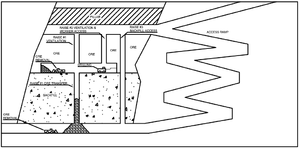 Schematic of a cut and fill mining operation in hard rock.
Schematic of a cut and fill mining operation in hard rock.
The process of mining from discovery of an ore body through extraction of minerals and finally to returning the land to its natural state consists of several distinct steps. The first is discovery of the ore body, which is carried out through prospecting or exploration to find and then define the extent, location and value of the ore body. This leads to a mathematical resource estimation to estimate the size and grade of the deposit.
This estimation is used to conduct a pre-feasibility study to determine the theoretical economics of the ore deposit. This identifies, early on, whether further investment in estimation and engineering studies is warranted and identifies key risks and areas for further work. The next step is to conduct a feasibility study to evaluate the financial viability, technical and financial risks and robustness of the project.
This is when the mining company makes the decision to develop the mine or to walk away from the project. This includes mine planning to evaluate the economically recoverable portion of the deposit, the metallurgy and ore recoverability, marketability and payability of the ore concentrates, engineering concerns, milling and infrastructure costs, finance and equity requirements and an analysis of the proposed mine from the initial excavation all the way through to reclamation. The proportion of a deposit that is economically recoverable is dependent on the enrichment factor of the ore in the area.
Once the analysis determines a given ore body is worth recovering, development begins to create access to the ore body. The mine buildings and processing plants are built and any necessary equipment is obtained. The operation of the mine to recover the ore begins and continues as long as the company operating the mine finds it economical to do so. Once all the ore that the mine can produce profitably is recovered, reclamation begins to make the land used by the mine suitable for future use.
Mining techniques
 Underground Longwall mining.
Underground Longwall mining.
Mining techniques can be divided into two common excavation types: surface mining and sub-surface (underground) mining. Surface mining is much more common, and produces, for example, 85% of minerals (excluding petroleum and natural gas) in the United States, including 98% of metallic ores.[23] Targets are divided into two general categories of materials: placer deposits, consisting of valuable minerals contained within river gravels, beach sands, and other unconsolidated materials; and lode deposits, where valuable minerals are found in veins, in layers, or in mineral grains generally distributed throughout a mass of actual rock. Both types of ore deposit, placer or lode, are mined by both surface and underground methods.
Processing of placer ore material consists of gravity-dependent methods of separation, such as sluice boxes. Only minor shaking or washing may be necessary to disaggregate (unclump) the sands or gravels before processing. Processing of ore from a lode mine, whether it is a surface or subsurface mine, requires that the rock ore be crushed and pulverized before extraction of the valuable minerals begins. After lode ore is crushed, recovery of the valuable minerals is done by one, or a combination of several, mechanical and chemical techniques.
Some mining, including much of the rare earth elements and uranium mining, is done by less-common methods, such as in-situ leaching: this technique involves digging neither at the surface nor underground. The extraction of target minerals by this technique requires that they be soluble, e.g., potash, potassium chloride, sodium chloride, sodium sulfate, which dissolve in water. Some minerals, such as copper minerals and uranium oxide, require acid or carbonate solutions to dissolve.[24][25]
Surface mining is done by removing (stripping) surface vegetation, dirt, and if necessary, layers of bedrock in order to reach buried ore deposits. Techniques of surface mining include; Open-pit mining which consists of recovery of materials from an open pit in the ground, quarrying or gathering building materials from an open pit mine, strip mining which consists of stripping surface layers off to reveal ore/seams underneath, and mountaintop removal, commonly associated with coal mining, which involves taking the top of a mountain off to reach ore deposits at depth. Most (but not all) placer deposits, because of their shallowly buried nature, are mined by surface methods. Landfill mining, finally, involves sites where landfills are excavated and processed.[26]
Sub-surface mining consists of digging tunnels or shafts into the earth to reach buried ore deposits. Ore, for processing, and waste rock, for disposal, are brought to the surface through the tunnels and shafts. Sub-surface mining can be classified by the type of access shafts used, the extraction method or the technique used to reach the mineral deposit. Drift mining utilizes horizontal access tunnels, slope mining uses diagonally sloping access shafts and shaft mining consists of vertical access shafts. Mining in hard and soft rock formations require different techniques.
Other methods include shrinkage stope mining which is mining upward creating a sloping underground room, long wall mining which is grinding a long ore surface underground and room and pillar which is removing ore from rooms while leaving pillars in place to support the roof of the room. Room and pillar mining often leads to retreat mining which is removing the pillars which support rooms, allowing the room to cave in, loosening more ore. Additional sub-surface mining methods include hard rock mining which is mining of hard materials, bore hole mining, drift and fill mining, long hole slope mining, sub level caving and block caving
Garzweiler open-pit mine, Germany
Machinery
 The Bagger 288 is a bucket-wheel excavator used in strip mining. It is also the largest land vehicle of all time.
The Bagger 288 is a bucket-wheel excavator used in strip mining. It is also the largest land vehicle of all time.
Heavy machinery is needed in mining for exploration and development, to remove and stockpile overburden, to break and remove rocks of various hardness and toughness, to process the ore and for reclamation efforts after the mine is closed. Bulldozers, drills, explosives and trucks are all necessary for excavating the land. In the case of placer mining, unconsolidated gravel, or alluvium, is fed into machinery consisting of a hopper and a shaking screen or trommel which frees the desired minerals from the waste gravel. The minerals are then concentrated using sluices or jigs.
Large drills are used to sink shafts, excavate stopes and obtain samples for analysis. Trams are used to transport miners, minerals and waste. Lifts carry miners into and out of mines, as well as moving rock and ore out, and machinery in and out of underground mines. Huge trucks, shovels and cranes are employed in surface mining to move large quantities of overburden and ore. Processing plants can utilize large crushers, mills, reactors, roasters and other equipment to consolidate the mineral-rich material and extract the desired compounds and metals from the ore.
Extractive metallurgy
Main article: extractive metallurgyThe science of extractive metallurgy is a specialized area in the science of metallurgy that studies the extraction of valuable metals from their ores, especially through chemical or mechanical means. Mineral processing (or mineral dressing) is a specialized area in the science of metallurgy that studies the mechanical means of crushing, grinding, and washing that enable the separation (extractive metallurgy) of valuable metals or minerals from their gangue (waste material). Since most metals are present in ores as oxides or sulfides, the metal needs to be reduced to its metallic form. This can be accomplished through chemical means such as smelting or through electrolytic reduction, as in the case of aluminium. Geometallurgy combines the geologic sciences with extractive metallurgy and mining.
Environmental effects
Main article: Environmental issues with miningEnvironmental issues can include erosion, formation of sinkholes, loss of biodiversity, and contamination of soil, groundwater and surface water by chemicals from mining processes. In some cases, additional forest logging is done in the vicinity of mines to increase the available room for the storage of the created debris and soil.[27] Contamination resulting from leakage of chemicals can also affect the health of the local population if not properly controlled.[28] Extreme examples of pollution from mining activities include coal fires, which can last for years or even decades, producing massive amounts of environmental damage.
Mining companies in most countries are required to follow stringent environmental and rehabilitation codes in order to minimize environmental impact and avoid impacts on human health. These codes and regulations all require the common steps of Environmental impact assessment, development of Environmental management plans, Mine closure planning (which must be done before the start of mining operations), and Environmental monitoring during operation and after closure. However, in some areas, particularly in the developing world, regulation may not be well enforced by governments.
For major mining companies, and any company seeking international financing, there are however a number of other mechanisms to enforce good environmental standards. These generally relate to financing standards such as Equator Principles, IFC environmental standards, and criteria for Socially responsible investing. Mining companies have used this financial industry oversight to argue for some level of self-policing.[29] In 1992 a Draft Code of Conduct for Transnational Corporations was proposed at the Rio Earth Summit by the UN Centre for Transnational Corporations (UNCTC), but the Business Council for Sustainable Development (BCSD) together with the International Chamber of Commerce (ICC) argued successfully for self-regulation instead.[30]
This was followed up by the Global Mining Initiative which was initiated by nine of the largest metals and mining companies, and led to the formation of the International Council on Mining and Metals to "act as a catalyst" for social and environmental performance improvement in the mining and metals industry internationally.[29] The mining industry has provided funding to various conservation groups, some of which have been working with conservation agendas that are at odds with emerging acceptance of the rights of indigenous people - particularly rights to make land-use decisions.[31]
Ore mills generate large amounts of waste, called tailings. For example, 99 tons of waste are generated per ton of copper, with even higher ratios in gold mining[citation needed]. These tailings can be toxic. Tailings, which are usually produced as a slurry, are most commonly dumped into ponds made from naturally existing valleys.[32] These ponds are secured by impoundments (dams or embankment dams).[32] In 2000 it was estimated that 3,500 tailings impoundments existed, and that every year, 2 to 5 major failures and 35 minor failures occurred;[citation needed] for example, in the Marcopper mining disaster at least 2 million tons of tailings were released into a local river.[33] Subaqueous tailings disposal is another option.[32] The mining industry has argued that submarine tailings disposal (STD), which disposes of tailings in the sea, is ideal because it avoids the risks of tailings ponds; although the practice is illegal in the United States and Canada, it is used in the developing world.[34]
Certification of mines with good practices occurs through the International Organization for Standardization (ISO) such as ISO 9000 and ISO 14001, which certifies an 'auditable environmental management system'; this certification involves short inspections, although it has been accused of lacking rigor.[29]:183-4 Certification is also available through Ceres' Global Reporting Initiative, but these reports are voluntary and unverified. Miscellaneous other certification programs exist for various projects, typically through nonprofit groups.[29]:185-6
Regulations and World Bank relationship
The World Bank has been involved in mining since 1955, mainly through grants from its International Bank for Reconstruction and Development, with the Bank's Multilateral Investment Guarantee Agency offering political risk insurance.[35] Between 1955 and 1990 it provided about $2 billion to fifty mining projects, broadly categorized as reform and rehabilitation, greenfield mine construction, mineral processing, technical assistance, and engineering. These projects have been criticized, particularly the Ferro Carajas project of Brazil, begun in 1981.[36] The bank established mining codes intended to increase foreign investment, in 1988 solicited feedback from 45 mining companies on how to increase their involvement.[29]:20
In 1992 the bank began to push for privatization of government-owned mining companies with a new set of codes, beginning with its report The Strategy for African Mining. In 1997, Latin America's largest miner Companhia Vale do Rio Doce (CVRD) was privatized. These and other movements such as the Philippines 1995 Mining Act led the World Bank to publish a third report (Assistance for Minerals Sector Development and Reform in Member Countries) which endorsed mandatory environment impact assessments and attention to the locals. The codes based on this report are influential in the legislation of developing nations. The new codes are intended to encourage development through tax holidays, zero custom duties, reduced income taxes, and related measures.[29]:22 The results of these codes were analyzed by a group from the University of Quebec, which concluded that the codes promote foreign investment but "fall very short of permitting sustainable development".[37] The observed negative correlation between natural resources and economic development is known as the resource curse.
Governance, New Regulation and Development
New regulation and process of legislative reforms aims to enrich the harmonization and stability of the mining sector in mineral-rich countries.[38] The new legislation for mining industry in the African countries still appears as an emerging issue with a potential to be solved, until a consensus is reached on the best approach.[39] By the beginning of 20th century the booming and more complex mining sector in mineral-rich countries provided only slight benefits to local communities in terms of sustainability. Increasing debates and influence by NGOs and communities appealed for a new program which would have had included also a disadvantaged communities, and would have had worked towards sustainable development even after mine closure (included transparency and revenue management). By the early 2000s, community development issues and resettlements became mainstreamed in Bank mining projects.[39] Mining-industry expansion after an increase of mineral prices in 2003 and also potential fiscal revenues in those countries created an omission in the other economic sectors in terms of finances and development. Furthermore, it had highlighted regional and local demand of mining-revenues and lack of ability of sub-national governments to use the revenues.
In 2007 the Extractive Industries Transparency Initiative (EITI) was mainstreamed in all countries cooperating with the World Bank in mining industry reform.[39] The EITI is operating and implementing with a support of EITI Multi-Donor Trust Fund, managed by The World Bank.[40] The Extractive Industries Transparency Initiative (EITI) aims to increase transparency in transactions between governments and companies within extractive industries[41] by monitoring the revenues and benefits between industries and recipient governments. The entrance process is voluntary for each country and is being monitored by multi-stakeholders involving government, private companies and civil society representatives, responsible for disclosure and dissemination of the reconciliation report;[39] however, the competitive disadvantage of company-by company public report is for some of the businesses in Ghana, the main constraint.[42] Therefore, the outcome assessment in terms of failure or success of the new EITI regulation does not only "rest on the government's shoulders" but also on civil society and companies.[43]
On the other hand, criticism points out two main implementation issues; inclusion or exclusion of artisanal mining and small-scale mining (ASM) from the EITI and how to deal with “non-cash” payments made by companies to subnational governments. Furthermore, disproportion of the revenues mining industry creates to the comparatively small number of people that it employs,[44] causes another controversy. The issue of artisanal mining is clearly an issue in EITI Countries such as the Central African Republic, D.R. Congo, Guinea, Liberia and Sierra Leone – i.e. almost half of the mining countries implementing the EITI.[44] Among other things, limited scope of the EITI involving disparity in terms of knowledge of the industry and negotiation skills, thus far flexibility of the policy (e.g. liberty of the countries to expand beyond the minimum requirements and adapt it to their needs), creates another risk of unsuccessful implementation. Public awareness increase, where government should act as a bridge between public and initiative for a successful outcome of the policy is an important element to be considered.[45]
Mining industry
Mining exists in many countries but Australia and Canada have a reputation for domestic mining expertise, and London is known as the capital of global "mining houses" such as Rio Tinto, BHP Billiton, and Anglo American PLC.[46] The US mining industry is also large but it is dominated by the coal and nonmetal minerals, and the various regulations have worked to reduce the significance of mining in the United States.[46] In 2007 the total market cap of mining companies was reported at US$962 billion, which compares to a total global market cap of publicly traded companies of about US$50 trillion in 2007.[47]
While exploration and mining can sometimes be conducted by individual entrepreneurs or small business, most modern-day mines are large enterprises requiring large amounts of capital to establish. Consequently, the mining sector of the industry is dominated by large, often multinational companies, most of them publicly listed. See Mining Companies for a list. It can be argued that what is referred to as the 'mining industry' is actually two sectors, one specializing in exploration for new resources, the other specializing in mining those resources. The exploration sector is typically made up of individuals and small mineral resource companies ("juniors") dependent on venture capital. The mining sector is typically large and multi-national companies sustained by mineral production from their mining operations. In addition to these two sectors, various other industries such as equipment manufacture, environmental testing and metallurgy analysis also rely on and support the mining industry throughout the world. Canadian stock exchanges have a particular focus on mining companies, particularly junior exploration companies through the TSX Venture Exchange; Canadian companies raise capital on these exchanges and then invest the money in exploration globally.[46] Some have argued that below juniors there exists a substantial sector of illegitimate companies primarily focused on manipulating stock prices.[46]
Mining operations can be grouped into five major categories in terms of their respective resources. These are, oil and gas extraction, coal mining, metal ore mining, nonmetallic mineral mining and quarrying, and support activities for mining.[48] Out of all these categories, oil and gas extraction remains one of the largest in terms of its global economic importance. Prospecting potential mining sites, a vital area of concern for the mining industry is now done using sophisticated new technologies such as seismic prospecting and remote-sensing satellites.
Corporate classifications
Mining companies can be classified based on their size and financial capabilities:
- Major companies are considered to have an adjusted annual mining-related revenue of more than US$500 million, with the financial capability to develop a major mine on its own.
- Intermediate companies have at least $50 million in annual revenue but less than $500 million.
- Junior companies rely on equity financing as their principal means of funding exploration. Juniors are mainly pure exploration companies, but may also produce minimally, and do not have a revenue of US$50 million.[49]
Safety
Safety has long been a controversial issue in the mining business especially with sub-surface mining. While mining today is substantially safer than it was in the previous decades, mining accidents are often very high profile, such as the Quecreek Mine Rescue saving 9 trapped Pennsylvania coal miners in 2002. The Courrières mine disaster, Europe's worst mining accident, caused the death of 1,099 miners (including many children) in Northern France on 10 March 1906. It seems that this disaster was surpassed only by the Benxihu Colliery accident in China on April 26, 1942, which killed 1,549 miners.[50] Government figures indicate that 5,000 Chinese miners die in accidents each year, while other reports have suggested a figure as high as 20,000.[51] Mining ventilation is a significant safety concern for many miners. Poor ventilation of the mines causes exposure to harmful gases, heat and dust inside sub-surface mines. These can cause harmful physiological effects, including death. The concentration of methane and other airborne contaminants underground can generally be controlled by dilution (ventilation), capture before entering the host air stream (methane drainage), or isolation (seals and stoppings).[52]
Ignited methane gas is a common source of explosions in coal mines, or, the more violent coal dust explosions. Gases in mines can also poison the workers or displace the oxygen in the mine, causing asphyxiation.[52] For this reason, the MHSA requires that workers have gas detection equipment in groups of miners. It must be able to detect common gases, such as CO, O2, H2S, and % Lower Explosive Limit. Additionally, further regulation is being requested for more gas detection as newer technology such as nanotechnology is introduced.
High temperatures and humidity may result in heat-related illnesses, including heat stroke which can be fatal. Dusts can cause lung problems, including silicosis, asbestosis and pneumoconiosis (also known as miners lung or black lung disease). A ventilation system is set up to force a stream of air through the working areas of the mine. The air circulation necessary for the effective ventilation of a mine is generated by one or more large mine fans, usually located above ground. Air flows in one direction only, making circuits through the mine such that each main work area constantly receives a supply of fresh air.
Miners utilize equipment strong enough to break through extremely hard layers of the Earth's crust. This equipment, combined with the closed workspace that underground miners work in, can cause hearing loss.[53] For example, a roof bolter (commonly used by mine roof bolter operators) can reach sound power levels of up to 115 dB.[53] Combined with the reverberant effects of underground mines, a miner without proper hearing protection is at a high risk for hearing loss.[53]
Since mining entails removing dirt and rock from its natural location creating large empty pits, rooms and tunnels, cave-ins are a major concern within mines. Modern techniques for timbering and bracing walls and ceilings within sub-surface mines have reduced the number of fatalities due to cave-ins, but accidents still occur.[citation needed] The presence of heavy equipment in confined spaces also poses a risk to miners, and despite modern improvements to safety practices, mining remains dangerous throughout the world.
Abandoned mines
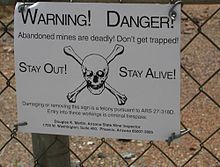 Warning sign near Jerome, Arizona
Warning sign near Jerome, Arizona
There are upwards of 560,000 abandoned mines on public and privately owned lands in the United States alone.[54][55] Abandoned mines may be dangerous to anyone who attempts to explore them without proper knowledge and safety training. Old mines are often dangerous and can contain deadly gases. Standing water in mines from seepage or infiltration poses a significant hazard as the water can hide deep pits and trap gases below the water. Additionally, since weather may have eroded the earth and rock surrounding it, the entrance to an old mine in particular can be very dangerous. Old mine workings, caves, etc. are commonly hazardous simply due to the lack of oxygen in the air, a condition in mines known as blackdamp.
Records
See also: Extremes_on_Earth#SubterraneanAs of 2008, the deepest mine in the world is TauTona in Carletonville, South Africa at 3.9 kilometers,[56] replacing the neighboring Savuka Mine in the North West Province of South Africa at 3,774 meters.[57] East Rand Mine in Boksburg, South Africa briefly held the record at 3,585 meters, and the first mine declared the deepest in the world was also TauTona when it was at 3,581 meters. The deepest mine in Europe is Bergwerk Saar in Saarland, Germany at 1,750 meters. The second deepest mine in Europe is Pyhäsalmi Mine in Pyhäjärvi, Finland at 1,444 meters. The third deepest mine in Europe is Boulby Mine England at 1,400 meters (shaft depth 1,100 meters).
The deepest open pit mine in the world is Bingham Canyon Mine in Bingham Canyon, Utah, United States at over 1,200 meters. The largest and second deepest open pit copper mine in the world is Chuquicamata in Chuquicamata, Chile at 900 meters, 940,600 tons of copper and 17,700 tons of molybdenum produced annually.[citation needed]
The deepest open pit mine with respect to sea level is Tagebau Hambach in Germany, where the ground of the pit is 293 meters below sea level.
The largest underground mine: El Teniente, in Rancagua, Chile, 2,400 kilometers of underground drifts, 418,000 tons of copper yearly. The deepest borehole in the world is Kola Superdeep Borehole at 12,262 meters. This, however, is not a matter of mining but rather related to scientific drilling.
Metal reserves and recycling
The extraction of metals has been closely linked to economic growth. During the 20th century, the variety of metals uses in society grew rapidly. Today, the development of major nations, such as China and India, and advances in technologies, are fuelling ever more demand. The result is that metal mining activities are expanding, and more and more of the world’s metal stocks are above ground in use, rather than below ground as unused reserves. An example is the in-use stock of copper. Between 1932 and 1999, copper in use in the USA rose from 73 g to 238 g per person.[58]
Metals are inherently recyclable, so in principle, can be used over and over again, minimizing the negative environmental impacts of mining and saving energy at the same time. For example, 95% of the energy used to make aluminium from bauxite ore is saved by using recycled material.[59] However, levels of metals recycling are generally low. In 2010, the International Resource Panel, hosted by the United Nations Environment Programme (UNEP) published reports on metal stocks that exist within society[60] and their recycling rates.[58]
The report authors observed that the metal stocks in society can serve as huge mines above ground. However, they warned that the recycling rates of some rare metals used in applications such as mobile phones, battery packs for hybrid cars and fuel cells, are so low that unless future end-of-life recycling rates are dramatically stepped up these critical metals will become unavailable for use in modern technology.
See also
- Mining engineering
- Outline of mining
- Landfill mining
- List of uranium mines
- Mineral industry
- Spoil tip
- Asteroid mining
Region specific:
- Colourful lakelets (in Poland)
- Mining and metallurgy in medieval Europe
- Mining in the Upper Harz
- Mining in Cornwall and Devon
- Canadian Mining Hall of Fame
- National Mining Hall of Fame (USA)
References
- ^ Hartman, Howard L. SME Mining Engineering Handbook, Society for Mining, Metallurgy, and Exploration Inc, 1992, p3.
- ^ Swaziland Natural Trust Commission, "Cultural Resources - Malolotja Archaeology, Lion Cavern," Retrieved August 27, 2007, [1].
- ^ Peace Parks Foundation, "Major Features: Cultural Importance." Republic of South Africa: Author. Retrieved August 27, 2007, [2].
- ^ Shaw, I. (2000). The Oxford History of Ancient Egypt. New York: Oxford University Press, pp. 57-59.
- ^ a b Shaw, I. (2000). The Oxford History of Ancient Egypt. New York: Oxford University Press, p. 108.
- ^ The Independent, 20 Jan. 2007: The end of a Celtic tradition: the last gold miner in Wales
- ^ The Romans in Britain: mining
- ^ A culture of Improvement. Robert Friedel. MIT Press. 2007. Pg.81
- ^ Medieval Science and Technology: Original Essays.Medieval Iron and Steel – Simplified Hall, Bert http://www.the-orb.net/encyclop/culture/scitech/iron_steel.html
- ^ http://mygeologypage.ucdavis.edu/cowen/~GEL115/115CH7.html
- ^ Heiss, A.G. & Oeggl, K. (2008). Analysis of the fuel wood used in Late Bronze Age and Early Iron Age copper mining sites of the Schwaz and Brixlegg area (Tyrol, Austria). Vegetation History and Archaeobotany 17(2):211-221, Springer Berlin / Heidelberg, [3].
- ^ The use of Firesetting in the Granite Quarries of South India Paul T. Craddock The Bulletin of the Peak District Mines Historical Society, Vol. 13 Number 1. 1996
- ^ "The Spanish Tradition in Gold and Silver Mining." Otis E. Young Arizona and the West, Vol. 7, No. 4 (Winter, 1965), pp. 299-314 (Journal of the Southwest) Stable URL: http://www.jstor.org/stable/40167137.
- ^ a b Lankton, L. (1991). Cradle to Grave: Life, Work, and Death at the Lake Superior Copper Mines. New York: Oxford University Press, p. 5-6.
- ^ a b c West, G.A. (1970). Copper: its mining and use by the aborigines of the Lake Superior Region. Westport, Conn: Greenwood Press.
- ^ a b Ricard, T. A. (1932), A History of American Mining, McGraw-Hill Book Company.
- ^ Bruno, L. & Heaman, L.M. (2004). Structural controls on hypozonal oroganic gold mineralization in the La Rouge Domain, Trans-Hudson Orogen, Saskatchewan. The Canadian Journal of Earth Sciences, Vol. 41, Issue 12, pp. 1453-1471.
- ^ Vaden, H.E. & Prevost. G. (2002). Politics of Latin America: The Power Game. New York: Oxford University Press, p. 34.
- ^ Maynard, S.R., Lisenbee, A.L. & Rogers, J. (2002). Preliminary Geologic Map of the Picture Rock 7.5 - Minute Quadrangle Sante Fe County, Central New Mexico. New Mexico Bureau of Geology and Mineral Resources, Open-File Report DM-49.
- ^ The Cerrillos Hills Park Coalition, (2000). Cerrillos Hills Historic Park Vision Statement. Public documents: Author. Retrieved August 27, 2007, [4].
- ^ McClure R, Schneider A. The General Mining Act of 1872 has left a legacy of riches and ruin. Seattle PI.
- ^ Boorstin, D.J. (1965). The Americans: The National Experience. New York: Vintage Books, pp. 78-81.
- ^ Hartmann HL. Introductory Mining Engineering, p. 11. First chapter.
- ^ http://world-nuclear.org/info/inf27.html
- ^ http://www.kazatomprom.kz/cgi-bin/index.cgi?p27&version=en
- ^ Landfill Mining Landfill Mining, Preserving Resources through Integrated Sustainable Management of Waste, Technical Brief from the World Resource Foundation
- ^ Logging of forests and debris dumping
- ^ Larmer, Brook (2009-01). "The Real Price of Gold". National Geographic. http://ngm.nationalgeographic.com/2009/01/gold/larmer-text/12.
- ^ a b c d e f Moody R. (2007). Rocks and Hard Places. Zed Books.
- ^ Abrahams D. (2005). Regulations for Corporations: A historical account of TNC regulation, p. 6. UNRISD.
- ^ Chapin, Mac (2004-10-15). "A Challenge to Conservationists: Can we protect natural habitats without abusing the people who live in them?". World Watch Magazine. 6 17. http://www.worldwatch.org/node/565. Retrieved 2010-02-18.
- ^ a b c US EPA. (1994). Technical Report: Design and Evaluation of Tailings Dams.
- ^ TE Martin, MP Davies. (2000). Trends in the stewardship of tailings dams.
- ^ Coumans C. (2002). Mining’s Problem with Waste. MiningWatch Canada.
- ^ For an overview of the Bank and mining, see Mining, Sustainability and Risk:World Bank Group Experiences.
- ^ See the 1995 World Development 23(3) pp. 385-400.
- ^ GRAMA. (2003). The Challenges of Development, Mining Codes in Africa And Corporate Responsibility. In: International and Comparative Mineral Law and Policy: Trends and Prospects. Summarized in the African Mining Codes Questioned.
- ^ Cambell, Bonnie (2008). "Regulation & Legitimacy in the Mining Industry in Africa: Where does". Review of African Political Economy 35 (3): 367–389. doi:10.1080/03056240802410984. http://docserver.ingentaconnect.com/deliver/connect/routledg/03056244/v35n3/s2.pdf?expires=1302287825&id=62185656&titleid=10738&accname=The+John+Rylands+University+Library%2C+The+University+of+Manchester&checksum=6F04E83AFE9F7C22DFB0A7848C306CC6. Retrieved 7 April 2011.
- ^ a b c d The World Bank. ces.worldbank.org/INTOGMC/Resources/336099-1288881181404/7530465-1288881207444/eifd19_mining_sector_reform.pdf "The World Bank's Evolutionary Approach to Mining Sector Reform". http://siteresour ces.worldbank.org/INTOGMC/Resources/336099-1288881181404/7530465-1288881207444/eifd19_mining_sector_reform.pdf. Retrieved 4 April 2011.
- ^ Extractive Industries Transparency Initiative. "Governance Structure". http://eiti.org/about/governance. Retrieved 4 April 2011.
- ^ Business and Human Right Resource Centre (2009). "Principles: Extractive Industries Transparency Initiative (EITI)". http://www.business-humanrights.org/Categories/Principles/ExtractiveIndustriesTransparencyInitiativeEITI. Retrieved 6 April 2011.
- ^ The Ghanaian Journal. "At the Fifth EITI Global Conference". http://www.theghanaianjournal.com/2011/03/16/at-the-fifth-eiti-global-conference/. Retrieved 3 April 2011.
- ^ Extractive Industries Transparency Initiative. [< http://eiti.org/files/Report_of_5th_EITI_Global_Conference.pdf "Report of 5th EITI Global Conference in Paris, 2011"]. < http://eiti.org/files/Report_of_5th_EITI_Global_Conference.pdf. Retrieved 4 April 2011.
- ^ a b World Bank’s Oil, Gas and Mining Policy and Operations Unit (COCPO). "Advancing the EITI in the Mining Sector: Implementation Issues". http://siteresources.worldbank.org/EXTOGMC/Resources/advancing_eiti_mining.pdf. Retrieved 6 April 2011.
- ^ Revenue Watch Institute 2010. "Promoting Transparency in the Extractive Sectors: An EITI Training for Tanzania Legislators". http://www.revenuewatch.org/news/news-article/tanzania/promoting-transparency-extractive-sectors-eiti-training-tanzania-legislat. Retrieved 6 April 2011.
- ^ a b c d MacDonald A. (2002). Industry in Transition: A Profile of the North American Mining Sector. Free full-text.
- ^ Reuters. Global stock values top $50 trln: industry data.
- ^ United States Bureau of Labor http://www.bls.gov/oco/cg/cgs004.htm#nature
- ^ "Metals Economics Group World Exploration Trends Report". Metals Economics Group Inc.. http://www.metalseconomics.com/pdf/PDAC%202009%20World%20Exploration%20Trends.pdf. Retrieved 2009-05-05.
- ^ (French) "Marcel Barrois". Le Monde. March 10, 2006. http://www.lemonde.fr/web/article/0,1-0@2-3226,36-749532,0.html.
- ^ "Where The Coal Is Stained With Blood". TIME. March 2, 2007
- ^ a b "NIOSH Mining Safety and Health Ventilation". United States National Institute for Occupational Safety and Health. http://www.cdc.gov/niosh/mining/topics/topicpage30.htm. Retrieved 2007-10-29.
- ^ a b c Peterson, J.S.; P.G. Kovalchik, R.J. Matetic (2006). "Sound power level study of a roof bolter" (PDF). Trans Soc Min Metal Explor (320): 171–7. http://www.cdc.gov/niosh/mining/pubs/pdfs/splso.pdf. Retrieved 2009-06-16.
- ^ Kertes, N., (March, 1996). US abandoned mine count still a mystery - General Accounting Office report. American Metal Market, Retrieved August 27, 2007, [5]
- ^ People, Land, and Water (March, 2007). KEEP OUT! Old Mines Are Dangerous. Office of Surface Mining: U.S. Department of the Interior. Retrieved Aug, 27, 2007, [6]
- ^ "TauTona, Anglo Gold - Mining Technology". SPG Media Group PLC. 2009-01-01. http://www.mining-technology.com/projects/tautona_goldmine/. Retrieved 2009-03-02.
- ^ Naidoo, Brindaveni (2006-12-15). "TauTona to take 'deepest mine' accolade". Creamer Media's Mining Weekly Online. Archived from the original on 2007-08-19. http://web.archive.org/web/20070819232301/http://www.miningweekly.co.za/article.php?a_id=98516. Retrieved 2007-07-19.
- ^ a b The Recycling Rates of Metals: A Status Report 2010, International Resource Panel, United Nations Environment Programme
- ^ Tread lightly: Aluminium attack Carolyn Fry, Guardian.co.uk, 22 February 2008.
- ^ Metal Stocks in Society: Scientific Synthesis 2010, International Resource Panel, United Nations Environment Programme
Further reading
- Ali, Saleem H. (2003) Mining, the Environment and Indigenous Development Conflicts. Tucson AZ: University of Arizona Press.
- Ali, Saleem H. (2009) Treasures of the Earth: need, greed and a sustainable future. New Haven and London: Yale University Press
- Even-Zohar, Chaim (2002). From Mine to Mistress: Corporate Strategies and Government Policies in the International Diamond Industry. Mining Journal Books. pp. 555. ISBN 0953733610.
- Geobacter Project: Gold mines may owe their origins to bacteria (in PDF format)
- Garrett, Dennis Alaska Placer Mining
- Jayanta, Bhattacharya (2007). Principles of Mine Planning (2nd ed.). Wide Publishing. pp. 505. ISBN 81-7764-480-7.
- Morrison, Tom (1992) Hardrock Gold: a miner's tale. ISBN 0-8061-2442-3
- John Milne: The Miner's Handbook: A Handy Reference on the subjects of Mineral Deposits(1894) Mining operations in the19th century.[7]
- Aryee, B., Ntibery, B., Atorkui, E. (2003) Trends in the small-scale mining of precious minerals in Ghana: a perspective on its environmental impact (in Journal of Cleaner Production 11: 131-140)
- The Oil, gas and Mining Sustainable Community Development Fund (2009) Social Mine Closure Strategy, Mali(in [8])
External links
Mining techniques Surface Sub-surface Cave topics and lists by country Main topics Speleology • Speleogenesis • Karst • Speleothem • Painting • Conservation • Caving • Cave survey • Caving equipment • List • Caves by countryTypes and
formationAnchihaline cave • Cave-in • Cenote • Foiba • Glacier cave • Ice cave • Lava cave • Ley tunnel • Mine (Exploration) • Pit cave • Sea cave • Show cave • Subterranean river • Sump • Underground lake • VugList (Africa) Algeria • Angola • Benin • Botswana • Burkina Faso • Burundi • Cameroon • Cape Verde • Central African Republic • Chad • Chagos • Comoros • Congo • DR Congo • Côte d'Ivoire • Djibouti • Egypt • List of caves in Equatorial Guinea • Eritrea • Ethiopia • Gabon • Gambia • Ghana • Guinea • Guinea-Bissau • Kenya • Lesotho • Liberia • Libya • Madagascar • Malawi • Mali • Mauritania • Mauritius • Mayotte • Morocco • Mozambique • Namibia • Niger • Nigeria • Réunion • Rwanda • Saint Helena • São Tomé and Príncipe • Senegal • Seychelles • Sierra Leone • Somalia • South Africa • South Sudan • Sudan • Swaziland • TAAF • Tanzania • Togo • Tunisia • Uganda • Western Sahara • Zambia • ZimbabweList (Americas) Anguilla • Antarctica • Netherlands Antilles • Antigua and Barbuda • Aruba • Argentina • Bahamas • Barbados • Belize • Bermuda • Bolivia • Brazil • Canada • Cayman Islands • Chile • Colombia • Costa Rica • Cuba • Dominica • Dominican Republic • Ecuador • El Salvador • Falkland Islands • Greenland • Grenada • Guadeloupe • Guatemala • Guyana • French Guyana • Haiti • Honduras • Jamaica • Martinique • Mexico • Montserrat • Nicaragua • Panama • Paraguay • Peru • Puerto Rico • St. Barthélemy • St. Kitts and Nevis • St. Lucia • St. Martin • St. Pierre and Miquelon • St. Vincent and the Grenadines • Suriname • Trinidad and Tobago • Turks and Caicos Island • United States (AR) • Uruguay • Venezuela • British Virgin Islands • US Virgin IslandsList (Asia) Afghanistan • Armenia • Azerbaijan • Bhutan • Brunei • Burma • Cambodia • China • Cyprus • Egypt • Georgia • India • Indonesia • Iran • Iraq • Israel • Japan • Jordan • Kazakhstan • North Korea • South Korea • Kuwait • Kyrgyzstan • Laos • Lebanon • Malaysia • Maldives • Mongola • Nepal • Oman • Pakistan • Palestine • Philippines • Qatar • Russia • Saudi Arabia • Singapore • Sri Lanka • Syria • Taiwan • Tajikistan • Thailand • Eest Timor • Turkey • Turkmenistan • United Arab Emirates • Uzbekistan • Vietnam • YemenList (Europe) Albania • Andorra • Armenia • Austria • Azerbaijan • Belarus • Belgium • Bosnia and Herzegovina • Bulgaria • Croatia • Cyprus • Czech Republic • Denmark • Estonia • Faroe Islands • Finland • France • Georgia • Germany • Gibraltar • Greece • Hungary • Iceland • Ireland • Italy • Kazakhstan • Kosovo • Latvia • Liechtenstein • Lithuania • Luxembourg • Macedonia • Malta • Moldova • Monaco • Montenegro • Netherlands • Norway • Poland • Portugal • Romania • Russia • San Marino • Serbia • Slovakia • Slovenia • Spain • Sweden • Switzerland • Turkey • Ukraine • United Kingdom (England, Northern Ireland, Scotland, Wales)List (Oceania) Australia (NSW, WA) • Cook Islands • Fiji • Guam • Indonesia • Kiribati • Marshall Islands • Micronesia • Nauru • New Caledonia • New Zealand • Northern Mariana Islands • Palau • Papua New Guinea • French Polynesia • Samoa • American Samoa • Solomon Islands • East Timor • Tuvalu • Vanuatu • Wallis and FutunaCategories:- Mining
- History of mining
- Occupational safety and health
Wikimedia Foundation. 2010.

